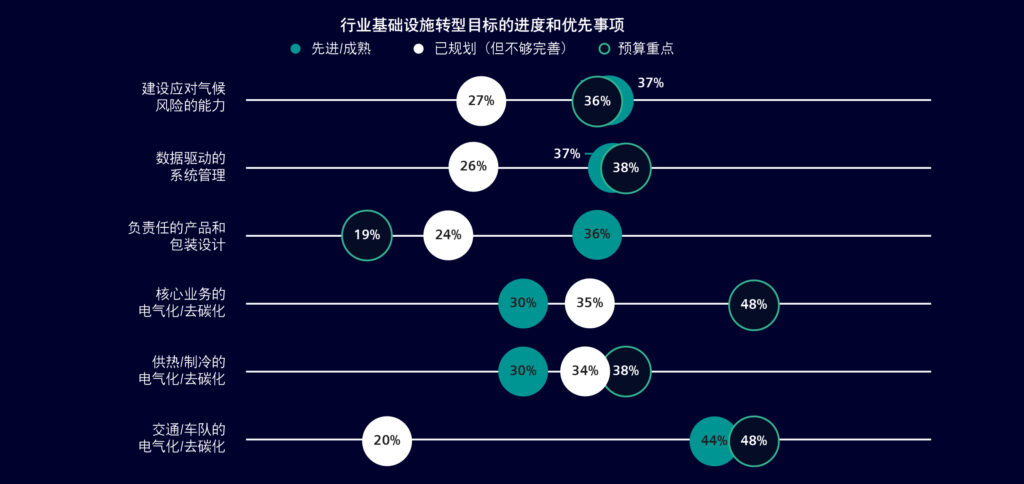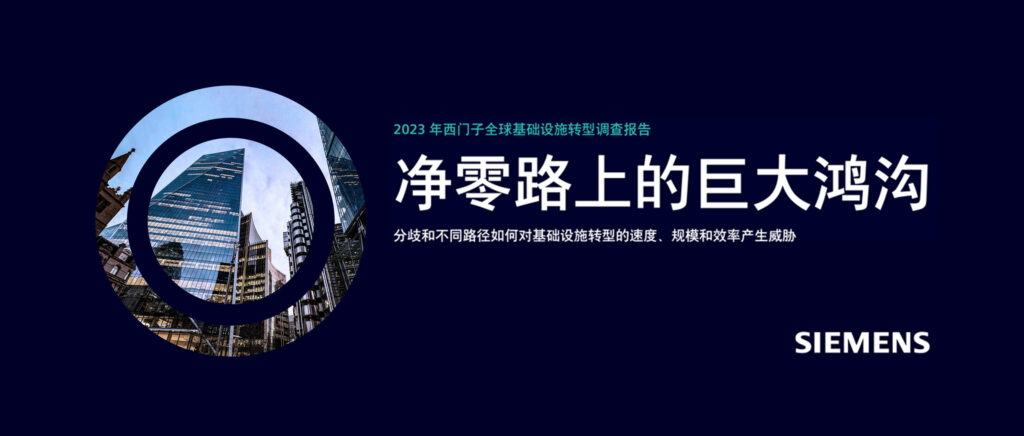近日,西门子发布了《2023西门子全球基础设施转型调查报告》,该报告详细研究了全球基础设施在进行减碳转型时面临的挑战和机遇。通过与全球1400家企业及其高管进行分析与沟通,该报告分析了基础设施转型的现状、当务之急以及未来的道路。
Siemens recently released the Siemens Global Infrastructure Transformation Survey 2023, which examines in detail the challenges and opportunities facing global infrastructure as it undergoes a carbon-reducing transformation. By analysing and communicating with 1,400 companies and their executives around the world, the report analyses the current state of infrastructure transformation, its imperatives, and the road ahead…

根据反馈,仅38%的受访高管认为他们所在的国家制定了统一或有效的去碳化战略。46%的受访者认为能够实现今年的去碳化目标,40%认为可能实现,44%认为不可能实现。在推动基础设施转型的过程中,监管机构承担着最大的责任。然而,在不同的实施阶段,监管机构还需要构建新的框架来治理一系列不断变化且不确定的系统。
Based on the feedback, only 38% of the executives surveyed believe that their country has a unified or effective decarbonization strategy. 46% of respondents believe that they will be able to meet this year’s decarbonization target, 40% believe it is likely, and 44% believe it is unlikely. Regulators bear the greatest responsibility in driving infrastructure transformation. However, regulators will also need to construct new frameworks to govern a changing and uncertain set of systems at different stages of implementation.

该报告最终得出如下三个结论。
The report draws in the following three conclusions:
⦁ 基础设施转型是在一个不断演变世界中的转变。它依据的并非总体蓝图,而是通过探索可能性、实施战略性建设和不断适应并调整这样一个循环逐步推进。
Infrastructure transformation is a shift in an evolving world. It is not based on an overarching blueprint, but rather progresses incrementally through a cycle of exploring possibilities, building strategically, and adapting and adjusting continuously.
⦁ 基础设施转型的紧迫性决定了这是一个无法避免的现实。政府间气候变化专门委员会的报告显示,全球气温的每一次上升都将“加剧多种同时发生的危险”,而如果要将升温幅度限制在 1.5 ° C 或 2 ° C 以下,我们必须“在 2030 年之前迅速且大幅减少所有行业的温室气体排放,而且大多数行业必须立即行动起来。”
The urgency of the infrastructure transition is such that it is an unavoidable reality. According to the Intergovernmental Panel on Climate Change (IPCC), each increase in global temperature will “exacerbate the risk of multiple simultaneous events”, and if we are to limit warming to less than 1.5 °C or 2 °C, we must “reduce greenhouse gas (GHG) emissions from all sectors, and most sectors must reduce their GHG emissions rapidly and substantially by 2030”. GHG emissions by 2030, and most industries must act now.
⦁ 基础设施转型的目标是重塑基础设施,不仅要实现能源系统和工业运营的去碳化,还要提高资源效率并产生积极的社会经济影响。
The goal of the Infrastructure Transformation is to reshape infrastructure not only to decarbonize energy systems and industrial operations, but also to improve resource efficiency and generate positive socio-economic impacts.
在中国市场,西门子作为仲欧脱碳科技(CNEUCN)的战略合作伙伴,以及专家委员会成员,一直参与到仲欧脱碳科技举行的各类活动。具体而言,西门子的智能基础设施和智慧楼宇产品,作为成熟的解决方案,为不同项目、在不同场合中,提供了大幅减少碳排放的方案。通过与仲欧脱碳科技的其他合作伙伴的通力协作,我们可以期待在未来,能够大规模实现碳中和目标。
In the Chinese market, Siemens is closely cooperating with China Europe Carbon Neutral (CNEUCN) as strategic business partner and CNEUCN’s Expert Committee member. In particular, by Siemens’s smart infrastructures and building products contribution it can be reached a substantial carbon emission reduction. Then, synergically operating with the other CNEUCN partners’ technologies and equipment, it can allow to reach the comprehensive carbon neutrality at large scale.

同时,西门子还参与到仲欧脱碳科技举行的各类会议和知识分享活动中。在过去一年里,仲欧脱碳科技通过诸多会议和活动,整合、协调其他世界领先的公司、专家群体通力协作,为各个不同的项目、城市、活动赋能。
By participating in various conferences and capacity building activities, held by CNEUCN, Siemens has been leveraging its presence in the carbon-neutrality related areas over the past year in China. Integration, synergic actions and value-added provision by many world leader experts and companies are among the added value characteristics of CNEUCN initiative.
与此同时,西门子还公布了五种能够在通往碳中和路上发挥重要作用的技术。
Five technologies solutions will play a fundamental role to reach carbon neutrality.
⦁ 智能电网
⦁ Smart Grids
通过智能配电,智能电网可以管理波动的能源供应和需求,实现 100% 的灵活性和稳定性,从而实现能源转型。智能电网是弹性和清洁能源系统的重要基石。
By an intelligent distribution, they manage fluctuating energy supply and demand to achieve 100% flexibility as well as stability for the energy transition. Smart grids are an essential cornerstone for a resilient and clean energy system.
⦁ 数字化脱碳平台
⦁ Digital decarbonization platforms
绘制和管理碳足迹,提供重要的透明度和数据。它们可以帮助解决产品高达 90% 的二氧化碳足迹问题。
Mapping and managing carbon footprints, they provide critical transparency and data. They can help to tackle up to 90% of a product’s CO2 footprint.
⦁ 根据现实状况建立数字孪生模型,对可持续性进行评估
⦁ Digital Twins virtual models for real world sustainability
模拟情景,提高效率,减少碳足迹。在这十年中,它们有可能减少 7.5 千兆吨的二氧化碳排放量。
Simulating scenarios, they can improve efficiency then reduce carbon footprints. Potentially they might save 7.5 gigatons of CO2 in this decade.
⦁ 增材制造
⦁ Additive manufacturing
简化供应链,提高生产灵活性,可帮助节省多达 70% 的原材料。
Streamlining the supply chains and enhancing the production agility, it can help to save up to 70% of raw materials.
⦁ 工业级别的人工智能
⦁ Industrial artificial intelligence
工业级的人工智能将能够优化交通、物流、建筑和智能电网系统的工作效率,能够实现可持续发展目标中的93%的环境目标。
As enabler and amplifier, it can optimize traffic-flows, buildings, smart-grids. IAI can enable 93% of the SDG’s environmental targets.
阅读报告原文请点击:
Read Full Report via:
https://www.siemens.com/cn/zh/company/topic-areas/intelligent-infrastructure.html
如想了解更多信息和更多详情,请联系: [email protected]
For more information and further details please write to: [email protected]
仲欧脱碳科技有限公司中欧碳中和可持续城市发展平台项目将由为此项目成立的同名私营公司运营,旨在通过聚集各方优势,针对每一个课题制定出量身打造的解决方案,以全面和包容的工作方式为中国和欧洲的碳中和之路添砖加瓦。
仲欧脱碳科技 有限公司该平台将发挥积极和创新的作用,为实现碳中和所需的构想、塑造、设计和实现转型提供服务。
China Europe Carbon Neutral Technology aims to support and substantially contribute to China and Europe path towards carbon neutrality in a holistic and inclusive way by gathering all the stakeholders and creating solutions for each challenge.
China Europe Carbon Neutral Technology will play an active and innovative role in providing services to conceive, shape, design and accomplish the transitions needed to achieve carbon neutrality.
Cover pic:
Will take some thing from the report it self.
